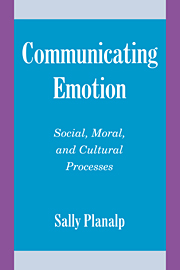Book contents
- Frontmatter
- Dedication
- Contents
- Acknowledgments
- Introduction
- 1 How Important Is Emotion in Everyday Interaction?
- 2 How and Why Is Emotion Communicated?
- 3 Is Emotional Communication Spontaneous or Strategic?
- 4 How Is Emotional Meaning Constructed Through Communication?
- 5 How Is Emotional Meaning Both Personal and Social?
- 6 How Do Emotion Messages Communicate Moral Meaning?
- 7 How Is Emotional Communication Grounded in Common Human Experience and Diverse Cultures?
- Epilogue: What is the Future of Emotional Meaning?
- References
- Author Index
- Subject Index
Introduction
Published online by Cambridge University Press: 05 February 2015
- Frontmatter
- Dedication
- Contents
- Acknowledgments
- Introduction
- 1 How Important Is Emotion in Everyday Interaction?
- 2 How and Why Is Emotion Communicated?
- 3 Is Emotional Communication Spontaneous or Strategic?
- 4 How Is Emotional Meaning Constructed Through Communication?
- 5 How Is Emotional Meaning Both Personal and Social?
- 6 How Do Emotion Messages Communicate Moral Meaning?
- 7 How Is Emotional Communication Grounded in Common Human Experience and Diverse Cultures?
- Epilogue: What is the Future of Emotional Meaning?
- References
- Author Index
- Subject Index
Summary
Ironically, we probably know more about the rings of Saturn than the emotions we experience every day.
(Lindsay-Hartz, 1984: 689)With a burst of new interest, scholars in the social sciences and the humanities are talking about emotion, and the public is joining in. There are several reasons. Sheer intellectual curiosity compels us to try to understand whatever is mysterious, and emotions are mysterious to most people. They are complicated physical, mental, social, moral, and cultural phenomena that provide new frontiers for human understanding. Feelings may be especially mysterious to many middle-class European Americans (academics in particular) because suppression has become something of a way of life (Stearns, 1994). Emotions have been ignored, denigrated, and cut off from the rest of social experience in much of the Western philosophical tradition (Solomon, 1993). They are viewed as beastly, infantile, crazy things that must be controlled for society to operate smoothly and rationally, or so everyday talk and practices suggest. Academic investigation, however, is all about challenging accepted truths and opening up new possibilities. As Woodward (1996: 774) puts it: “Scholars in the humanities and social sciences have been working assiduously to rescue the emotions from cultural contempt.”
The world is also forcing us to come to terms with emotion. Carmichael (1991: 185-186) writes that “This century, more than any other in human history, has brought us a terrifying awareness of the dark and evil capacities of human nature.– It has been the realization that rationality and reason have failed that shocked us.” Today's papers have news about massacres in Mexico and Algeria; not long ago they were in Bosnia, Rwanda, and El Salvador. Emotional problems surround us – road rage, epidemic levels of depression, homicidal jealousy, suicidal love, and genocidal hatred and fear. Rationality does not seem to be an effective antidote, so perhaps the solution lies in understanding emotion on its own terms.
Emotions need to be recognized and respected in everyday talk and interaction because emotion is meaningful and meaning is emotional, whether we like it or not. By emotional meaning, I do not mean the kind of abstract, derived meaning that we find in dictionaries, but the meaning by which people live their lives.
- Type
- Chapter
- Information
- Communicating EmotionSocial, Moral, and Cultural Processes, pp. 1 - 8Publisher: Cambridge University PressPrint publication year: 1999



